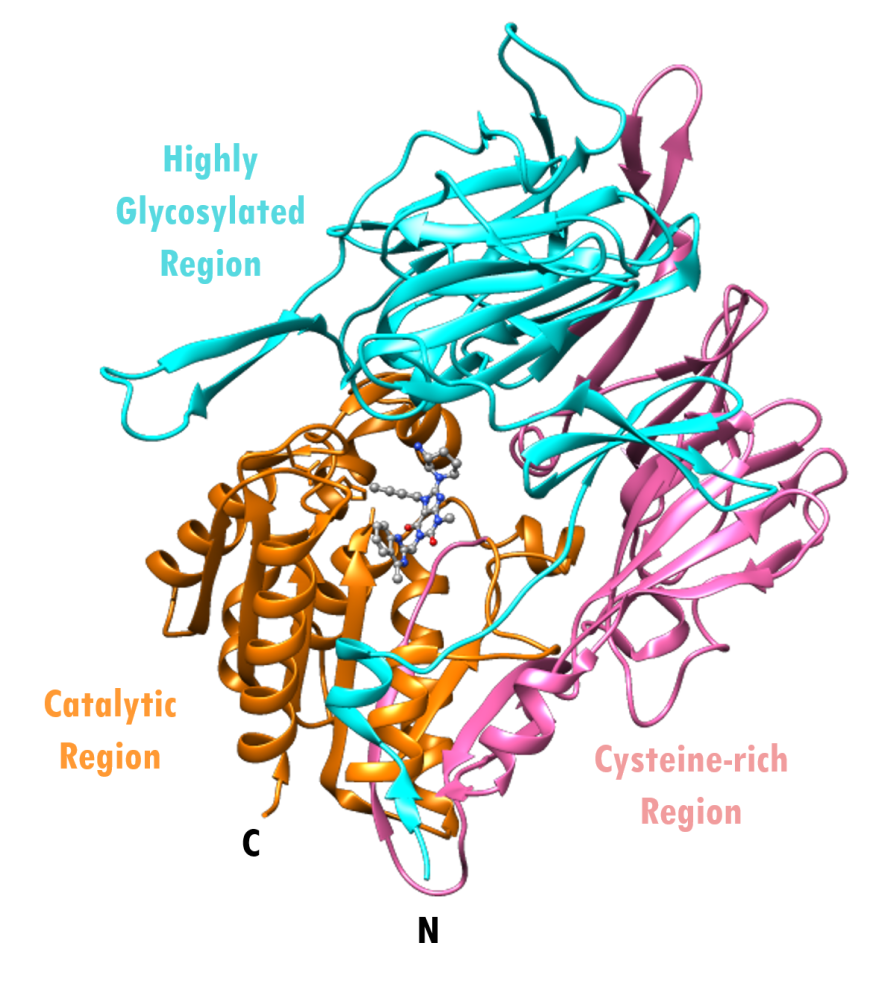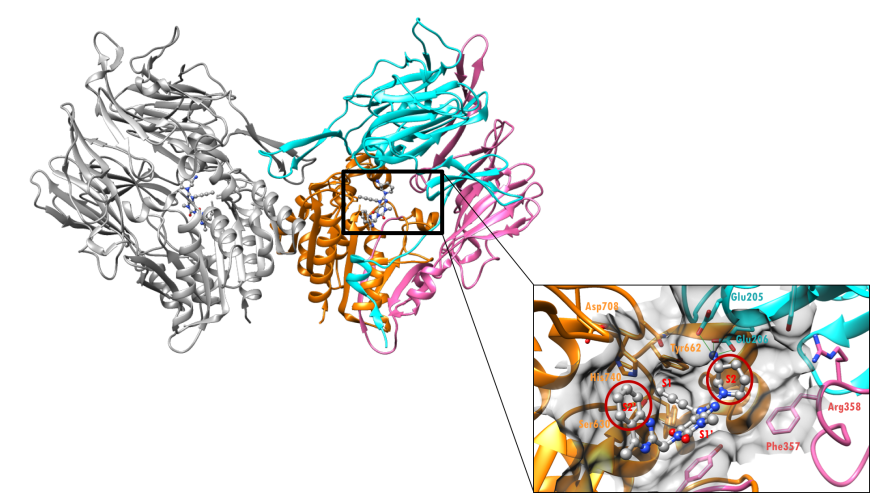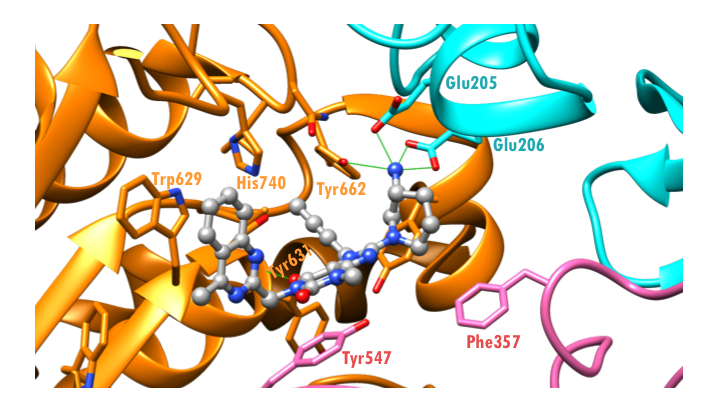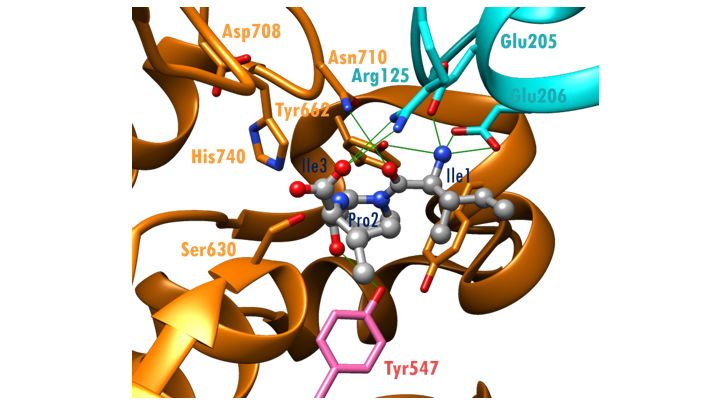Linagliptin
Table 1. Basic profile of linagliptin
| Description | Oral anti-diabetic drug |
| Target(s) | Dipeptidyl peptidase-4 (DPP-4) |
| Generic | Linagliptin |
| Commercial Name | Tradjenta® (United States, Canada) |
| Combination Drug(s) | Glyxambi® (linagliptin & empagliflozin) |
| Other Synonyms | BI-1356, Ondero |
| IUPAC Name | 8-[(3R)-3-aminopiperidin-1-yl]-7-but-2-yn-1-yl-3-methyl-1-[(4-methylquinazolin-2-yl)methyl]-3,7-dihydro-1h-purine-2,6-dione |
| Ligand Code in PDB | 356 |
| 3D Structure of linagliptin bound to target protein DPP-4 | PDB ID 2rgu |
|
|
|
Drug Information
Table 2. Chemical and physical properties (DrugBank). *Note: Predicted values may slightly vary from source to source.
| Chemical Formula | C25H28N8O2 |
| Molecular Weight | 472.23 g/mol |
| Calculated Predicted Partition Coefficient: cLogP* | 2.62 |
| Calculated Predicted Aqueous Solubility: cLogS* | -4 |
| Solubility (in water) | 0.0502 mg/mL (sparingly soluble) |
| Predicted Topological Polar Surface Area (TPSA)* | 113.48 Å2 |
Drug Target
Linagliptin is an orally active, antidiabetic drug that works by inhibiting the enzyme dipeptidyl peptidase-4 (DPP-4) (Eckhardt et al., 2007). In response to food intake, endocrine cells in the gastrointestinal tract release incretin hormones, GLP-1 and GIP, to stimulate insulin secretion. Normally, DPP-4 degrades the incretin hormones within a few minutes of their release, thereby playing a key role in regulating the duration of incretin hormone function. Linagliptin, is a xanthine-based, non-substrate-like inhibitor of DPP-4. By blocking DPP-4 enzymatic activity, linagliptin increases the half-life of the incretin hormones, which in turn stimulates increased secretion of insulin by pancreatic β-cells and reduces secretion of glucagon by pancreatic α-cells. Collectively, these functions lower blood glucose levels. Since the incretins, GLP-1 and GIP, are only released after eating, DPP-4 inhibitors typically do not induce hypoglycemia (Aschner et al., 2006).
Learn more about DPP-4 here.
Drug-Target Complex
Each molecule of the DPP-4 enzyme is a transmembrane glycoprotein made up of 766 amino acids and consists of five regions:
- a cytoplasmic region (residues 1–6) not crystallized/not shown
- a trans-membrane region (residues 7–28) not crystallized/not shown
- a highly-glycosylated region (residues 29–323) colored cyan
- a cysteine-rich region (residues 324–551) colored pink
- a catalytic region (residues 552–766) colored orange
The overall structure of the extracellular portion of the enzyme, showing the highly glycosylated, cysteine-rich, and catalytic regions can be seen in Figure 2.

|
| Figure 2. Overall structure of human DPP-4 monomer, complexed with linagliptin. The enzyme is shown in ribbon representation highlighting the N- and C-termini and various regions of the protein - cysteine-rich region (pink), highly glycosylated region (cyan) and catalytic domain (orange). Linagliptin is shown in ball-and-stick representation (PDB ID: 2rgu; Eckhardt et al., 2007). |
The DPP-4 enzyme functions as a dimer, composed of two copies of the same protein (Figure 3).Linagliptin has been structurally derived from the xanthine scaffold (Deacon et al. 2010). It is a non-substrate-like inhibitor of DPP-4. This class of DPP-4 inhibitors does not mimic the dipeptidic nature of the DPP-4 substrates. Instead, it binds non-covalently to DPP-4 through hydrophobic and hydrogen-bonding interactions, and an aromatic group usually occupies the S1 hydrophobic sub-pocket of the active site of DPP-4.

|
| Figure 3. X-ray crystal structure of the DPP-4 dimer (ribbons), with bound linagliptin (ball-and-stick). The DPP-4 monomer on the right is color-coded by region as in Figure 2 and the monomer on the left is shown as a grey ribbon (PDB ID: 2rgu; Eckhardt et al., 2007). The surface of the active site of DPP-4 is shown in the inset. Linagliptin is shown in a ball-and-stick representation, color-coded by atom type (C: gray; N: blue; O: red). Selected residues in the active sites are shown as stick figures. |
Closer examination of the co-crystal structure of DPP-4 and linagliptin (Eckhardt et al., 2007) reveals multiple interactions of the drug with its pharmacological target, DPP-4 (Figure 4). The aminopiperidine motif, on one end of the drug, occupies the and S2 sub-site of the enzyme and the amine of this group forms hydrogen bonds with contributions from residues Glu205, Glu206, and Tyr662. Another hydrogen bond is formed between the carbonyl group of the xanthine scaffold and the backbone amide of residue Tyr631. The hydrophobic butynyl group of the drug occupies the S1 site (Figure 3, Figure 4), lined by several tyrosines, including Tyr662. The uracil ring of the xanthine scaffold has π-stacking interactions with Tyr547 (Figure 4), while the quinazoline ring has π-stacking interactions with Trp629 (Figure 4). Together, these interactions account for the tight binding of linagliptin with DPP-4 (IC50 < 2 nm).
 |
 |
| Figure 4. Hydrogen bonding interactions (green lines) between linagliptin (ball-and-stick) and active site residues (stick figure) (PDB ID: 2rgu; Eckhardt et al., 2007). | Figure 5. Hydrogen bonding interactions (green lines) between Diprotin A (ball-and-stick) and active site residues (stick figure) (PDB ID: 1nu8; Thoma et al., 2003). |
Comparison of the co-crystal structures of DPP-4 with linagliptin (PDB ID 2rgu, Figure 4) and Diprotin A with DPP-4 (PDB ID 1nu8, Figure 5) shows that linagliptin acts by occluding the DPP-4 active site and prevents binding of incretin hormones.
Pharmacologic Properties and Safety
Table 3. Pharmacokinetics: ADMET of linagliptin
| Features | Comment(s) | Source |
|---|---|---|
| Bioavailability (%) | 30% | (Nakamura et al., 2015) |
| IC50 (nM) | 0.1-2 nM | BindingDB |
| Ki (nM) | 1 nM | (Guedes et al., 2013) |
| Half-life (hrs) | 120-184 hours | (Capuano et al., 2013) |
| Duration of Action | 24 hours | (Drugs.com) |
| Absorption | Human intestinal absorption | (DrugBank) |
| Transporter(s) | multidrug resistance protein 1 | (DrugBank) |
| Metabolism | Cytochrome p450 3A4 | (DrugBank) |
| Excretion | ~85% urine; ~5% feces | (Capuano et al., 2013) |
| AMES Test (Carcinogenic Effect) | probability 0.5444 (Non-AMES toxic) | (DrugBank) |
| hERG Safety Test (Cardiac Effect) | probability 0.6109 (weak inhibitor) | (DrugBank) |
| Liver Toxicity | In 2014, a single case of liver injury due to linagliptin was reported. | (LiverTox) |
The half-life elimination of linagliptin is 120-184 hours, a longer persistence in comparison to that of other DPP-4 inhibitors. For instance, saxagliptin has a half-life of roughly 2.2-3.8 hours and aloglitpin is cleared from the plasma within approximately 12.4-21.4 hours (Capuano et al., 2013). Linagliptin’s longer survival time is beneficial for individuals who may accidentally skip taking their medication since the drug may remain in the system for a few days. Therefore, a once-daily dosing is appropriate since inhibition of DPP-4 activity is sustained for a long period of time. Approximately 85-90% of the drug is excreted unchanged via the entero-hepatic system as feces (80%) and urine (5%), while 10% of the drug is minimally metabolized by cytochrome P450 3A4 (CYP3A4).
Drug Interactions and Side Effects
Hypoglycemia is uncommon with linagliptin alone (in <1% patients), but occurs in higher rates when it is combined with other oral hypoglycemic agents. Concomitant administration of single doses of linagliptin with insulin secretagogues (e.g. glyburide) or insulin may cause an elevated risk of hypoglycemia and adverse cardiovascular complications (PubChem).
Table 4. Drug interactions and side effects of linagliptin
| Features | Comment(s) | Source |
|---|---|---|
| Total Number of Drugs Interactions | 686 | (Drugs.com) |
| Major Drug Interactions | bexarotene and gatifloxacin | (Drugs.com) |
| Alcohol/Food Interaction(s) | moderate interaction with alcohol (ethanol) | (Drugs.com) |
| Disease Interaction(s) | pancreatitis (major) | (Drugs.com) |
| On-target Side Effects | abdominal pain, upper respiratory tract infection, diarrhea, constipation, urinary tract infection (UTI), pancreatitis | (Drugs.com) |
| Off-target Side Effects | nasopharyngitis, cough, angioedema, rash, headache, depression, anxiety; blurred vision, skin exfoliation | (Drugs.com) |
Regulatory Approvals/Commercial
Tradjenta® (linagliptin) was developed by Boehringer Ingelheim and approved for use by the US FDA in 2011. It is prescribed as an oral medication in 5 mg tablets, taken once a day, regardless of meals (DrugBank). The cost of a 30-day supply of 5mg tablets of linagliptin is about US $243.60, which comes out to $8.12 /day.
Links
Table 5. Links to Relevant Resources
| DrugBank | http://www.drugbank.ca/drugs/DB08882 |
| Drugs.com | https://www.drugs.com/cdi/linagliptin.html |
| Food and Drugs Administration | https://www.accessdata.fda.gov/drugsatfda_docs/label/2012/201280s005lbl.pdf |
| National Institutes of Health (NIH) | http://livertox.nlm.nih.gov/Linagliptin.htm |
| PubChem | https://pubchem.ncbi.nlm.nih.gov/compound/10096344 |
References
Aschner, P., Kipnes, M. S., Lunceford, J. K., Sanchez, M., Mickel, C., and Williams-Herman, D. E. (2006) Effect of the Dipeptidyl Peptidase-4 Inhibitor Sitagliptin as Monotherapy on Glycemic Control in Patients with Type 2 Diabetes. Diabetes Care 29, 2632-2637. https://doi.org/10.2337/dc06-0703
Capuano, A., Sportiello, L., Maiorino, M. I., Rossi, F., Giugliano, D., and Esposito, K. (2013) Dipeptidyl Peptidase-4 Inhibitors in Type 2 Diabetes Therapy – Focus on Alogliptin. Drug, Design, Development and Therapy 213, 989-1001. https://doi.org/10.2147/DDDT.S37647
Deacon, C. F, and Holst, J. J. (2010) Linagliptin, a xanthine-based dipeptidyl peptidase-4 inhibitor with an unusual profile for the treatment of type 2 diabetes. Expert Opinion on Investigational Drugs 19, 133-140. https://doi.org/10.1517/13543780903463862
Eckhardt, M., Langkopf, E., Mark, M., Tadayyon, M., Thomas, L., Nar, H., Pfrengle, W., Guth, B., Lotz, R., Sieger, P., Fuchs, H., and Himmelsbach, F. (2007) 8-(3-(R)-Aminopiperidin-1-Yl)-7-But-2-Ynyl-3-Methyl-1-(4-Methyl-Quinazolin-2-Ylmethyl)-3,7-Dihydropurine-2,6-Dione (BI 1356), a Highly Potent, Selective, Long-Acting, and Orally Bioavailable DPP-4 Inhibitor for the Treatment of Type 2 Diabetes. Journal of Medicinal Chemistry 50, 6450-6453. https://doi.org/10.1021/jm701280z
Guedes, E. P., Hohl, A., de Melo, T. G., and Lauand, F. (2013) Linagliptin: Farmacology, Efficacy and Safety in Type 2 Diabetes Treatment. Diabetololgy & Metabolic Syndrome 5, 1-7. https://doi.org/10.1186/1758-5996-5-25
Linagliptin. Drugbank.ca. https://www.drugbank.ca/drugs/DB08882
Linagliptin. Livertox.nlm.nih.gov. https://livertox.nlm.nih.gov/Linagliptin.htm
Linagliptin. Pubchem.ncbi.nlm.nih.gov. https://pubchem.ncbi.nlm.nih.gov/compound/10096344
Linagliptin - Affinity Data by PDB ID. Bindingdb.org. http://www.bindingdb.org/jsp/dbsearch/PrimarySearch_pdbids.jsp?pdbids_submit=Search&pdbids=2RGU
Linagliptin Uses, Side Effects & Warnings. Drugs.com. https://www.drugs.com/mtm/linagliptin.html
Nakamura, Y., Hasegawa, H., Tsuji, M., Udaka, Y., Mihara, M., Shimizu, T., Inoue, M., Goto, Y., Gotoh, H., Inagaki, M., and Oguchi, K. (2015) Diabetes Therapies in Hemodialysis Patients: Dipeptidase-4 Inhibitors. World Journal of Diabetes 6, 840-849. https://doi.org/10.4239/wjd.v6.i6.840
Thoma, R., Loffler, B., Stihle, M., Huber, W., Ruf, A., and Hennig, M. (2003) Structural basis of proline-specific exopeptidase activity as observed in human dipeptidyl peptidase-IV. Structure 11, 947-959. https://doi.org/10.1016/S0969-2126(03)00160-6
September 2017, Jennifer Jiang, Dr. Sutapa Ghosh ; Reviewed by Drs. Stephen K. Burley and Kathleen Aertgeerts
http://dx.doi.org/10.2210/rcsb_pdb/GH/DM/drugs/dppi/linagliptin




